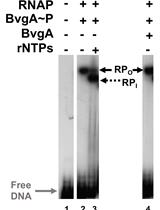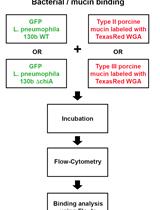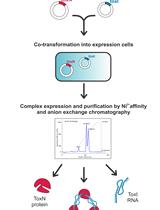- Submit a Protocol
- Receive Our Alerts
- Log in
- /
- Sign up
- My Bio Page
- Edit My Profile
- Change Password
- Log Out
- EN
- EN - English
- CN - 中文
- Protocols
- Articles and Issues
- For Authors
- About
- Become a Reviewer
- EN - English
- CN - 中文
- Home
- Protocols
- Articles and Issues
- For Authors
- About
- Become a Reviewer
Producing GST-Cbx7 Fusion Proteins from Escherichia coli
Published: Vol 7, Iss 12, Jun 20, 2017 DOI: 10.21769/BioProtoc.2333 Views: 11487
Reviewed by: Arsalan DaudiThibaud T. RenaultJose Thekkiniath

Protocol Collections
Comprehensive collections of detailed, peer-reviewed protocols focusing on specific topics
Related protocols

Combining Gel Retardation and Footprinting to Determine Protein-DNA Interactions of Specific and/or Less Stable Complexes
Meng-Lun Hsieh [...] Deborah M. Hinton
Dec 5, 2020 3519 Views

Assay for Assessing Mucin Binding to Bacteria and Bacterial Proteins
Lubov S. Grigoryeva [...] Nicholas P. Cianciotto
Mar 5, 2021 4686 Views

Large-scale Purification of Type III Toxin-antitoxin Ribonucleoprotein Complex and its Components from Escherichia coli for Biophysical Studies
Parthasarathy Manikandan [...] Mahavir Singh
Jul 5, 2023 2132 Views
Abstract
This protocol describes the production of GST-Cbx7 fusion proteins from E. coli, originally developed in the recent publication (Zhen et al., 2016). The pGEX-6P-1-GST plasmids encoding the Cbx7 variants were transformed into BL21 competent cells. The fusion protein production was induced by isopropyl-beta-D-thiogalactopyranoside and they were purified by Glutathione Sepharose 4B. This protocol can be adapted for the purification of other proteins.
Keywords: PolycombBackground
Polycomb group (PcG) proteins regulate gene expression by modulating higher order chromatin structures (Kerppola, 2009; Simon and Kingston, 2013). PcG proteins are generally found in two major complexes, Polycomb repressive complex (PRC) 1 and 2 (Kerppola, 2009; Simon and Kingston, 2013). PRC2 is a methyltransferase that catalyzes di- and tri-methylation of lysine 27 on histone H3 (H3K27me2/3) (Cao et al., 2002); PRC1 is an ubiquitin ligase that monoubiquitylates histone H2A on lysine 119 (H2AK119Ub) (Wang et al., 2004). Mammalian PRC1 complexes are further divided to canonical and variant PRC1 (Gao et al., 2012, Tavares et al., 2012). Canonical PRC1 is composed of one of each Ring1 (Ring1A/Ring1B), Pcgf (Mel18/Bmi1), Phc (Phc1/2/3), and Cbx (Cbx2/4/6/7/8) proteins. The Cbx family proteins have a conserved chromodomain (CD) that recognizes H3K27me3, suggesting molecular links between the recruitment of canonical PRC1 and H3K27me3 (Blackledge et al., 2015). Recently, we have interrogated the molecular mechanisms underlying the binding of Cbx7-PRC1 to chromatin by live-cell single-molecule imaging (Zhen et al., 2016). We showed that the CD and AT-hook-like (ATL) motif of Cbx7 constitute a functional DNA-binding unit by electrophoretic mobility shift assay (Zhen et al., 2016). Here, detailed conditions are presented which allow the production of GST-Cbx7 fusion proteins from E. coli. With modifications, this protocol may be used for the purification of other proteins. The purification of fusion proteins by GST fusion system has been widely applied in various biochemical and structural studies (Harper and Speicher, 2011).
Materials and Reagents
- 50 ml conical tube
- Dialysis membrane (Spectra/Por® Molecularporous membrane tubing, standard RC tubing, MWCO: 3.5 kD) (Spectrum, catalog number: 132720 )
- Bio-Rad Chromatography Column (2.5 x 10 cm Econo-Column) (Bio-Rad Laboratories, catalog number: 7311550 )
- BL21 competent cells (made in the laboratory)
- pGEX-6P-1-GST (GE Healthcare)
- Ampicillin
- Isopropyl-1-thio-β-D-galactopyranoside (IPTG) (Omega Bio-tek, catalog number: AC121 )
- Glutathione Sepharose 4B (GE Healthcare, catalog number: 17075601 )
- Phosphate-buffered saline (PBS, pH 7.4)
- PierceTM Coomassie (Bradford) Protein Assay Kit (Thermo Fisher Scientific, Thermo ScientificTM, catalog number: 23200 )
- Coomassie Blue (Bio-Rad Laboratories, catalog number: 1610786 )
- Tryptone
- Yeast extract
- Sodium chloride (NaCl)
- 1% Triton X-100
- Phenylmethanesulfonyl fluoride (PMSF) (Sigma-Aldrich, catalog number: 93482 )
- Protease inhibitor cocktail (Sigma-Aldrich, catalog number: P8340 )
- L-glutathione reduced (Sigma-Aldrich, catalog number: G4251 )
- LB medium (see Recipes)
- Wash buffer (see Recipes)
- Lysis buffer (see Recipes)
- Elution buffer (see Recipes)
Equipment
- Culture flasks (2,000 ml) (NALGENE, U.S.A.)
- Shaker
- Centrifuges (Eppendorf, model: 5702 R )
- Centrifuge bottle
- Vibra-CellTM sonicator (Sonics & Materials, model: VCX 130 ) with standard probe (1/4”; 6 mm), length 4.5” (113 mm), Titanium alloy Ti-6Al-4V, Autoclavable (Sonics & Materials, catalog number: 630-0435 )
- S-3200-2 GyroMixer (BioExpress, model: GeneMate GyroMixer , catalog number: S-3200-2)
Procedure
Note: The experimental procedure was revised from the published protocol (Harper and Speicher, 2011).
- Expression of GST fusion protein
- Transform competent BL21 cells with pGEX-6P-1-GST plasmids that encode the Cbx7 variants by incubating plasmid with cells on ice for 10 min, then heat shock at 42 °C for 45 sec. The mixture was put on ice for 2 min, LB medium was added, and the mixture was incubated for 1 h at 37 °C while shaking at 250-300 rpm. After that, the cells were spread onto agar plate containing ampicillin.
- Transfer a single, isolated colony of transformed BL21 cells to 100 ml LB medium with 100 µg/ml ampicillin and incubate the inoculated culture overnight at 37 °C while shaking at 250-300 rpm.
- Transfer 50 ml of the overnight culture into 950 ml of warm, fresh LB medium with 100 µg/ml ampicillin.
- Incubate the culture at 37 °C while shaking at 250-300 rpm until the OD600 is 0.5-0.7 (Note 1).
- Induce the protein expression by adding IPTG to a final concentration of 1.0 mM (stock concentration: 100 mM, the powder was dissolved in MilliQ water and the solution was filtered before used) and incubating at 37 °C while shaking at 250-300 rpm for 5 h.
- Harvest cells by centrifugation at 4,000 x g for 20 min at 4 °C.
- Carefully decant the supernatant, leaving about 15-50 ml in the centrifuge bottle.
- Resuspend the cells and transfer to a 50 ml conical tube and centrifuge at 4,000 x g for 20 min at 4 °C.
- Decant the supernatant (Note 2).
- Transform competent BL21 cells with pGEX-6P-1-GST plasmids that encode the Cbx7 variants by incubating plasmid with cells on ice for 10 min, then heat shock at 42 °C for 45 sec. The mixture was put on ice for 2 min, LB medium was added, and the mixture was incubated for 1 h at 37 °C while shaking at 250-300 rpm. After that, the cells were spread onto agar plate containing ampicillin.
- Sonication (Note 3)
- Resuspend the cell pellet in 25 ml of lysis buffer.
- Lyse cells by sonication at 4 °C using the standard probe with the following settings:
- 15-sec on
- 45-sec off
- 45% input (45% amplitude)
- 6 min: total time on
- Resuspend the cell pellet in 25 ml of lysis buffer.
- Purification
- To the mixture after sonication, add Triton X-100 to a final concentration of 1% and mix gently for 30 min at 4 °C with the mixer to increase the solubility of the protein.
- Centrifuge the mixture at 10,000 x g for 10 min at 4 °C.
- Wash 0.75 ml of Glutathione Sepharose beads with 3 x 10 ml of cold PBS, centrifuge at 500 x g for 3 min at 4 °C.
- Transfer the supernatant by pipetting from step C2 to pre-washed beads in a conical tube and rotate at 4 °C for 1 h.
- Centrifuge at 500 x g for 3 min at 4 °C and remove the supernatant.
- Wash the beads with 4 x 10 ml of wash buffer.
- Pour the beads into a Bio-Rad Chromatography Column and wash with 2 x 10 ml of cold PBS.
- Elute the fusion protein by incubating at room temperature for 10 min with 1 ml elution buffer. Repeat this step to get a total of three elutions.
- Dialyze against PBS three times.
- Run SDS-PAGE gel to determine the purity and identity of the fusion protein (Figure 1).

Figure 1. SDS-PAGE gel stained with Coomassie for determination of Cbx7 variant GST-fusion proteins
- To the mixture after sonication, add Triton X-100 to a final concentration of 1% and mix gently for 30 min at 4 °C with the mixer to increase the solubility of the protein.
Data analysis
The PierceTM Coomassie (Bradford) Protein Assay Kit (Thermo Scientific) was performed to determine the concentration of the protein. SDS-PAGE gel was used to determine the identity of the proteins by their expected molar mass and also to check for contaminates (if yes, there will be other bands shown together with the protein band). Furthermore, GST protein was run with the SDS-PAGE gel as a control. The gel was stained with Coomassie Blue and is presented in Figure 6-figure supplement 1 in (Zhen et al., 2016): Live-cell single-molecule tracking reveals co-recognition of H3K27me3 and DNA targets polycomb Cbx7-PRC1 to chromatin.
Notes
- To monitor the OD, measure the absorbance at 600 nm. Estimate the amount of time by assuming the population of E. coli doubles every 20 min.
- The cell pellet from step C10 can be frozen at -80 °C for several months.
- For sonication: cell disruption is evidenced by partial clearing of the suspension. Avoid over sonication since it will heat the solution, leading to protein aggregation and denaturation.
- After sonication, 1% Triton X-100 was added, Triton X-100 can be replaced with other detergents such as NP-40 or Tween 20.
Recipes
- LB medium (Autoclaved, 1 L, pH 7.2)
10 g tryptone
5 g yeast extract
5 g NaCl - Wash buffer
1x PBS + 1% Triton X-100 - Lysis buffer
1x PBS
0.1 mM PMSF
0.1 mM protease inhibitor cocktail - Elution buffer
20 mM reduced glutathione, pH 8.0
Adjust pH with NaOH
Acknowledgments
This work was supported, in whole or in part, by the National Cancer Institute of the National Institutes of Health under Award Number R03CA191443 (to XR). This work was also supported by grants from the CU-Denver Office Research Service (to XR) and the American Cancer Society Grant IRG 57-001-53 subaward (to XR).
This protocol was modified from (Harper and Speicher, 2011).
References
- Blackledge, N. P., Rose, N. R. and Klose, R. J. (2015). Targeting Polycomb systems to regulate gene expression: modifications to a complex story. Nat Rev Mol Cell Biol 16(11): 643-649.
- Cao, R., Wang, L., Wang, H., Xia, L., Erdjument-Bromage, H., Tempst, P., Jones, R. S. and Zhang, Y. (2002). Role of histone H3 lysine 27 methylation in Polycomb-group silencing. Science 298(5595): 1039-1043.
- Gao, Z., Zhang, J., Bonasio, R., Strino, F., Sawai, A., Parisi, F., Kluger, Y. and Reinberg, D. (2012). PCGF homologs, CBX proteins, and RYBP define functionally distinct PRC1 family complexes. Mol Cell 45(3): 344-356.
- Harper, S. and Speicher, D. W. (2011). Purification of proteins fused to glutathione S-transferase. Methods Mol Biol 681: 259-280.
- Kerppola, T. K. (2009). Polycomb group complexes--many combinations, many functions. Trends Cell Biol 19(12): 692-704.
- Simon, J. A. and Kingston, R. E. (2013). Occupying chromatin: Polycomb mechanisms for getting to genomic targets, stopping transcriptional traffic, and staying put. Mol Cell 49(5): 808-824.
- Tavares, L., Dimitrova, E., Oxley, D., Webster, J., Poot, R., Demmers, J., Bezstarosti, K., Taylor, S., Ura, H., Koide, H., Wutz, A., Vidal, M., Elderkin, S. and Brockdorff, N. (2012). RYBP-PRC1 complexes mediate H2A ubiquitylation at polycomb target sites independently of PRC2 and H3K27me3. Cell 148(4): 664-678.
- Wang, H., Wang, L., Erdjument-Bromage, H., Vidal, M., Tempst, P., Jones, R. S. and Zhang, Y. (2004). Role of histone H2A ubiquitination in Polycomb silencing. Nature 431(7010): 873-878.
- Zhen, C. Y., Tatavosian, R., Huynh, T. N., Duc, H. N., Das, R., Kokotovic, M., Grimm, J. B., Lavis, L. D., Lee, J., Mejia, F. J., Li, Y., Yao, T. and Ren, X. (2016). Live-cell single-molecule tracking reveals co-recognition of H3K27me3 and DNA targets polycomb Cbx7-PRC1 to chromatin. Elife 5.
Article Information
Copyright
Huynh and Ren . This article is distributed under the terms of the Creative Commons Attribution License (CC BY 4.0).
How to cite
Readers should cite both the Bio-protocol article and the original research article where this protocol was used:
- Huynh, T. N. and Ren, X. (2017). Producing GST-Cbx7 Fusion Proteins from Escherichia coli. Bio-protocol 7(12): e2333. DOI: 10.21769/BioProtoc.2333.
- Zhen, C. Y., Tatavosian, R., Huynh, T. N., Duc, H. N., Das, R., Kokotovic, M., Grimm, J. B., Lavis, L. D., Lee, J., Mejia, F. J., Li, Y., Yao, T. and Ren, X. (2016). Live-cell single-molecule tracking reveals co-recognition of H3K27me3 and DNA targets polycomb Cbx7-PRC1 to chromatin. Elife 5.
Category
Microbiology > Microbial biochemistry > Protein > Interaction
Biochemistry > Protein > Isolation and purification
Do you have any questions about this protocol?
Post your question to gather feedback from the community. We will also invite the authors of this article to respond.
Share
Bluesky
X
Copy link








